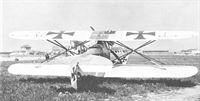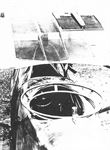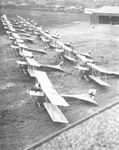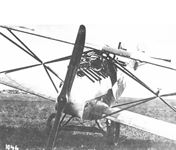C.Owers Hansa-Brandenburg Aircraft of WWI Vol.1: Landplanes (A Centennial Perspective on Great War Airplanes 17)
Type K (C.II)
A two-seat observation biplane derived from the Type KDD the Type K became the C.II.(17) Two were constructed by Brandenburg. The machine had the star strutter form of interplane struts and as there were problems with the wing cellule the fuselage was constructed first while awaiting test results. The fuselage was deep and rectangular in section. The top wing was mounted close to the fuselage giving the observer a superb field of fire forwards and rearwards over the tail. A balanced rudder was fitted without fin. While the pilot was not enclosed as in the Type KDD, he was situated wholly under the upper wing with no easy escape in the event of a crash. A single machine gun was provided for the observer. On initial flight tests the performance was reported as good but Flars expressed concern over the pyramid strut arrangement. The prototype 66.51 was flown at Briest where it was inspected by Austro-Hungarian representatives. The pilot's view needed improvement and its performance was considered not satisfactory for the mountainous country that it would have to operate in.
The second machine, 66.81, carried out flight tests in June 1917 but had poor flight characteristics. Its poor longitudinal stability was blamed on the heavier 200-hp Hiero engine. Plans to lengthen the fuselage and provide an enlarged fin were halted while the L 15 was completed. By August 1917 the modified C.II was ready for flight test but the success of the Phonix C.I and UFAG C.I reconnaissance two-seaters meant that the project was abandoned. Both these machines were developed with conventional wing bracing from their Brandenburg predecessors to become very successful machines.
(17) The Type K is illustrated in the Typenschau by a three-view drawing. The C.II is presented as the Phonix C.II in this volume.
Type K (C.II) Specifications
Source Typenschau Type K Typenschau UFAG KD* Brandenburg 3-View PMG 66.51
Span, m 9.40/9.40 9.40 9.400 9.40/9.40
Length, m 7.40 7.40 7.400 7.40
Wing Area, m2 28.83 28.83 28.83 28.03
Empty Wt., kg 736 736 728 728
Loaded Wt., kg 1,100 1,100 1,092 1,092
Time to 1000 m 3.5 min 3.5 min 3 min 30
Motor 180-hp Austro-Daimler 200-hp Austro-Daimler 180-hp Austro 185-hp Daimler
* The type is also identified in the Typenschau as the Phonix C.II with the same specifications.
P.Grosz, G.Haddow, P.Shiemer Austro-Hungarian Army Aircraft of World War One
Brandenburg C.II Series 66.5 and 66.8
On 25 August 1916, the LFT signed a provisional production contract for a two-seat observation biplane (derived from the Type KDD (60.56) prototype) that later became known as the Brandenburg C.II (Type K). Two batches were ordered, consisting of eight C.II series 66.5 biplanes powered by a 160 hp Daimler engine and 40 C.II series 67.5 biplanes powered by a 200 hp Hiero engine. In late 1916 the contract was changed, calling for 24 C.II series 66.5 (Daimler) and 24 C.II series 66.8 (Hiero) biplanes. On 21 November 1916, Flars cancelled the Brandenburg contract, preferring to have Phonix and UFAG manufacture the C.II under license at lower cost. However, the prototype development program at all three companies remained a priority undertaking.
Brandenburg had begun preliminary design work on the Type K (C.II) in June 1916, choosing to build the fuselage first to await the outcome of the static load tests of the pyramid wing cellule that had been giving difficulties. The deep rectangular fuselage, which filled the wing gap, provided the observer with a superb field of fire over the top wing and tail. The first layout envisioned the pilot as totally encapsulated within the fuselage, his only view provided by two side windows as in the 60.56 (Type KDD). When the C.II 66.51 prototype was rolled out in October 1916 for flight tests, the pilot was located in an open cockpit but still situated under the center section. Flight performance was reported as "exceptionally good." The Flars commissioning team that visited Briest in January 1917 was pleased by the fine performance but voiced concern over the difficulty of pilot egress and the structural integrity of the pyramid strut configuration.
The C.II 66.51 was flight tested from January to March 1917 at Aspern. Test pilots Oberleutnant Oskar Fekete and Stabsfeldwebel Kurt Gruber reported it as easy to fly, showing none of the unpleasant shortcomings of the Brandenburg D.I, but the rate of climb, directional stability, and pilot's view required improvement. In comparison to the Aviatik C.I, Fekete felt the C.II's higher landing speed, poor glide ratio, and slower climb made it less suitable for mountainous terrain and small airfields. The prototype was accepted by Flars on 21 February 1917. Brandenburg delivered a new wing cellule that was flight evaluated between 2-14 May 1917 but offered no improvement. In May, work on the 66.51 prototype was halted in favor of the more-promising C.II derivatives, the Phonix C.I series 121 and the UFAG C.I series 161. The 66.51 airframe was stored at Aspern from March to October 1918.
The second C.II 66.81 was completed on 18 May 1917. Flight tests carried out in June proved unsatisfactory due to "the poor longitudinal stability" induced by the heavier 200 hp Hiero engine. The construction of an enlarged fin and lengthened fuselage was temporarily halted to give priority to the L 15 prototype. On 8 August 1917 the modified 66.81 stood ready to recommence flight testing, but promising results achieved with the Phonix C.I and UFAG C.I made it unwise to expend further effort on the Brandenburg design. The 66.81 was stored in damaged condition at Aspern in October 1918.
Brandenburg C.II 66.51
Engine: 185 hp Daimler
Wing: Span Upper 9.40 m (30.84 ft)
Span Lower 9.40 m (30.84 ft)
Chord Upper 1.65 m (5.41 ft)
Chord Lower 1.65 m (5.41 ft)
Dihedral Upper 0 deg
Dihedral Lower 0 deg
Sweepback Upper 0 deg
Sweepback Lower 0 deg
Gap 1.61 m(5.28 ft)
Stagger 0.48 m (1.57 ft)
Total Wing Area 28.03 sq m (302 sq ft)
General: Length 7.40 m (24.28 ft)
Track 1.72 m (5.64 ft)
Empty Weight 728 kg (1605 lb)
Loaded Weight 1092 kg (2408 lb)
Climb: 1000m (3,281 ft) in 3 min 30 sec
Brandenburg C.II(U) Series 66
No aircraft carrying the series 66 designation were built by UFAG. Records show that in 1916 UFAG received a contract for 24 Brandenburg C.II(U) series 66 biplanes based on the Brandenburg C.II 66.51 prototype currently under development at Briest. When the two UFAG-built Brandenburg C.II prototypes made their appearance in March 1917, Flars had changed the designations to Brandenburg C.II(U) 161.01 and 161.02. But with the arrival of the two UFAG C.I production prototypes, Flars changed the numbers once again. The two Brandenburg C.II(U) prototypes were renumbered to 160.01 and 160.02, and the UFAG C.I prototypes were assigned the numbers 161.01 and 161.02.
Brandenburg C.II(U) Series 160
In July 1916, UFAG received a contract to build 24 Brandenburg C.II(U) series 66 biplanes based on the Brandenburg C.II 66.81 prototype. When UFAG completed the two C.II(U) prototypes, Flars had changed the designation to 161.01 and 161.02. Both prototypes were powered by a 200 hp Hiero engine. A Flars commissioning team inspected the 161.01 airframe on 29 March 1917. Test flying delayed by weather had made little progress when, in May 1917, Flars cancelled the Brandenburg C.II program because the performance did not meet frontline requirements and the derivative UFAG C.I showed far more promise. When the UFAG C.I series 161 production prototypes (161.01 and 161.02) appeared in May 1917, to avoid confusion the two Brandenburg C.II(U) prototypes were re-numbered 160.01 and 160.02. It appears the C.II(U) aircraft were flown sporadically through early 1918. In test pilot Antal Feher's logbook one can read that climb trials with aircraft 160.01 and 160.02 were performed in January 1918. In March, the two prototypes went to Flek 8 as ground instruction airframes.
Brandenburg C.II(U) 160.02 Specifications
Engine: 200 hp Hiero
Climb: 1000m (3,281 ft) in 4 min 27 sec (160.02)
2000m (6,562 ft) in 10 min 46 sec (160.02)
3000m (9,843 ft) in 16 min 53 sec (160.02)
An Explanatory Note About Hansa-Brandenburg Serial Numbers:
When the LFT assigned new serial numbers to aircraft in February 1915, Hansa-Brandenburg was assigned the company designation 05. The first nine numbers, 05.01 to 05.09, were allocated to out-of-series or prototype aircraft. Series production aircraft began with the Hansa-Brandenburg B.I 05.11. At a later date, production aircraft were numbered 61.5 and up and prototype aircraft were assigned numbers beginning with 60.5. To avoid confusion, the table shows the series designations assigned to Brandenburg and UFAG, although the types were not identical nor were parts interchangeable:
Type UFAG Hansa-Brandenburg
Brand C.I 61.01-24 61.51-72
Brand G.I 62.01-12 62.51-77
Brand C.I 63.01-32 63.51-86
Brand C.I 64.01-48 64.51-72
Brand D.I not built by UFAG 65.50-99
Brand C.II 66.01 (cancelled) 66.51 (two built)
E.Hauke, W.Schroeder, B.Totschinger Die Flugzeuge der k.u.k. Luftfahrtruppe und Seeflieger 1914-1918
60. Flugzeuge der Ungarischen Flugzeugfabrik A.G. (Ufag) Budapest und Hansa Brandenburgische Flugzeugfabrik Brandenburg/Briest
66.51 Brandenburg C.II (Br) Dm 185
66.81 Brandenburg C.II (Br) H 200
 |
C.Owers - Hansa-Brandenburg Aircraft of WWI. Volume 1 - Landplanes /Centennial Perspective/ (17)
|
| The Type K/Brandenburg C.II 66.51 at Aspern during performance evaluation. The engine cowling has been scooped out to provide forward visibility for the pilot during landing.
|
 |
P.Grosz, G.Haddow, P.Shiemer - Austro-Hungarian Army Aircraft of World War One /Flying Machines/
|
| Brandenburg C.II(U) 161.01, powered by a 200 hp Hiero engine, at the UFAG factory in Albertfalva in April 1917. To avoid confusion with the UFAG C.I 161.01 prototype, the number was later changed to 160.01.
|
 |
C.Owers - Hansa-Brandenburg Aircraft of WWI. Volume 1 - Landplanes /Centennial Perspective/ (17)
|
Brandenburg C.II 66.51. According to Brandenburg, the wing cellule was identical with that of the CC flying boat. The deep fuselage design was put to good use in the Brandenburg W 12 seaplane.
The C.II was a typical Brandenburg structure with deep ply covered fuselage. The pilot's position under the upper wing gave him poor visibility and lack of egress in the event of a bad landing.
|
 |
E.Hauke, W.Schroeder, B.Totschinger - Die Flugzeuge der k.u.k. Luftfahrtruppe und Seeflieger 1914-1918
|
| Brandenburg K, Flugzeugnummer 66.51
|
 |
P.Grosz, G.Haddow, P.Shiemer - Austro-Hungarian Army Aircraft of World War One /Flying Machines/
|
| Brandenburg C.II 66.51. The low rudder and high fuselage provided the rear gunner with an unobstructed field of fire. The center section above the pilot’s cockpit was covered with transparent Cellon.
|
 |
P.Grosz, G.Haddow, P.Shiemer - Austro-Hungarian Army Aircraft of World War One /Flying Machines/
|
| The Brandenburg C.II 66.51 (Type K), powered by a 160 hp Daimler engine, at Aspern in January 1917. As in the 60.57, the pilot had no easy egress in the event of a crash.
|
 |
C.Owers - Hansa-Brandenburg Aircraft of WWI. Volume 1 - Landplanes /Centennial Perspective/ (17)
|
|
|
 |
C.Owers - Hansa-Brandenburg Aircraft of WWI. Volume 1 - Landplanes /Centennial Perspective/ (17)
|
| Brandenburg C.II 66.51 on the Phonix airfield with Phonix fighter prototype 60.58, the L 14.
|
 |
P.Grosz, G.Haddow, P.Shiemer - Austro-Hungarian Army Aircraft of World War One /Flying Machines/
|
| The modified Brandenburg L 14, designated 60.58, at Aspern for evaluation in the summer of 1917. On the left is the the Phonix C.I 121.03 and on the right the Brandenburg C.II 66.51.
|
 |
C.Owers - Hansa-Brandenburg Aircraft of WWI. Volume 1 - Landplanes /Centennial Perspective/ (17)
|
| Detail views of Brandenburg C.II 66.51 showing tail details.
|
 |
C.Owers - Hansa-Brandenburg Aircraft of WWI. Volume 1 - Landplanes /Centennial Perspective/ (17)
|
| This view of Brandenburg C.II 66.51 shows engine details and the cellon windows in the center section of the upper wing.
|
 |
C.Owers - Hansa-Brandenburg Aircraft of WWI. Volume 1 - Landplanes /Centennial Perspective/ (17)
|
| Detail views of Brandenburg C.II 66.51 showing engine details.
|
 |
C.Owers - Hansa-Brandenburg Aircraft of WWI. Volume 1 - Landplanes /Centennial Perspective/ (17)
|
| The pilot's location provided no upward view and Cellon windows were inserted into the center section; however, the location of the radiator blocked part on the starboard side.
|
 |
P.Grosz, G.Haddow, P.Shiemer - Austro-Hungarian Army Aircraft of World War One /Flying Machines/
|
| Brandenburg C.II(U) 161.01 (later 160.01). The inaccessible cockpit location, which made a quick exit difficult in an emergency, explains why pilots had such an aversion to the aircraft. The center section is covered with transparent Cellon.
|
 |
P.Grosz, G.Haddow, P.Shiemer - Austro-Hungarian Army Aircraft of World War One /Flying Machines/
|
| Seventeen Brandenburg C.I(U) biplanes (left front: 69.71 and 69.35) and one Brandenburg C.II(U) lined up for flight acceptance at the UFAG airfield in Albertfalva, April 1917.
|
 |
P.Grosz, G.Haddow, P.Shiemer - Austro-Hungarian Army Aircraft of World War One /Flying Machines/
|
| The Brandenburg C.II 66.81, powered by a 200 hp Hiero engine, damaged in a minor landing accident at Aspern. The side hatch to the pilot's cockpit is open. This prototype was fitted with a rounded rudder.
|
 |
C.Owers - Hansa-Brandenburg Aircraft of WWI. Volume 1 - Landplanes /Centennial Perspective/ (17)
|
| Brandenburg Type K Factory Drawing
|
 |
C.Owers - Hansa-Brandenburg Aircraft of WWI. Volume 1 - Landplanes /Centennial Perspective/ (17)
|
|
|
 |
P.Grosz, G.Haddow, P.Shiemer - Austro-Hungarian Army Aircraft of World War One /Flying Machines/
|
| Brandenburg C.II 66.51
|




















